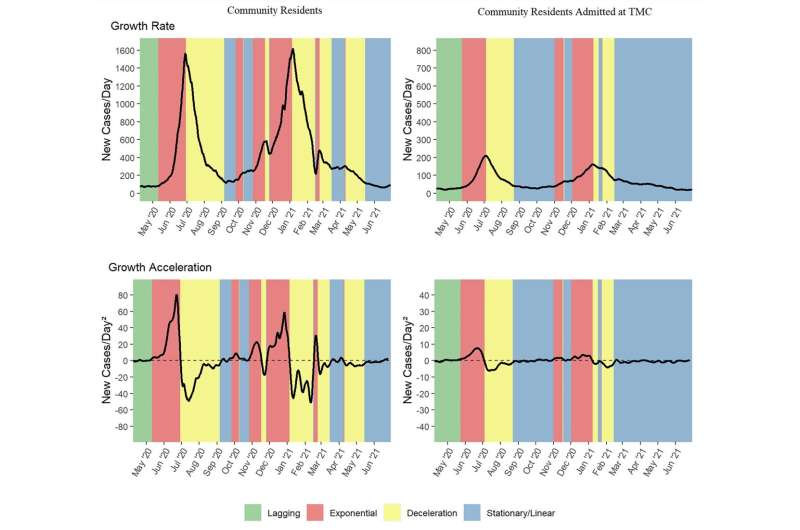Method for detecting waves of COVID-19 infections can shape critical public health decisions during a pandemic

A method that combines case investigation data from local health departments and hospitalizations records from local institutions allows for the objective detection of new waves of infection during a pandemic, according to research from UTHealth Houston.
Results of the findings were published in Scientific Reports.
"Early in the pandemic, most predictive models trying to forecast new waves failed. This was partially due to limited knowledge or data on major factors influencing community transmission. In addition, conditions influencing the spread of infections were changing fast—mask use requirements, measures to restrict mobility, school and business closings," said Marcia Otto, Ph.D., MS, lead author and associate professor of epidemiology at UTHealth School of Public Health. "Messy, 'real-world' data can be difficult to use. We needed a method that could reliably detect new outbreak waves and determine the critical time period before local hospitals might become overwhelmed."
To conduct their study, the researchers used two sets of data: case investigation data from the Harris County Public Health Department, and molecular test results from patients admitted to Texas Medical Center institutions.
They adapted a framework previously published in Frontiers in Medicine using the Hidden Markov model to identify four phases in an outbreak wave: lagging, exponential/rapid growth, deceleration, and stationary/linear. This previous work had been used to describe outbreak waves in various countries, but had not been used to quantify the dynamics of transmission or severe disease in local communities, which is crucial to help inform public health strategies to protect and care for people in need of testing or hospital care.
"Unprecedented collaboration made this work possible, including public health science, practice, and public health leadership," Otto said. "That collaboration is critical to care for local communities."
Two large waves were detected in Harris County. The first wave, from May 12 to September 20, 2020, took 12 days to travel from the local community to hospitals settings. The second, from September 27, 2020, to May 15, 2021, took longer at 36 days. This work was conducted in collaboration with Harris County Public Health and Harris Health.
"The methods developed as part of this work are currently being used to monitor the dynamics of community transmission in real time in Harris and Fort Bend Counties, and could be used to track infectious diseases of broad transmissibility in the future" Otto said.
More information: Marcia C. de Oliveira Otto et al, Case growth analysis to inform local response to COVID-19 epidemic in a diverse U.S community, Scientific Reports (2022). DOI: 10.1038/s41598-022-20502-2
Yuri Tani Utsunomiya et al, Growth Rate and Acceleration Analysis of the COVID-19 Pandemic Reveals the Effect of Public Health Measures in Real Time, Frontiers in Medicine (2020). DOI: 10.3389/fmed.2020.00247




















